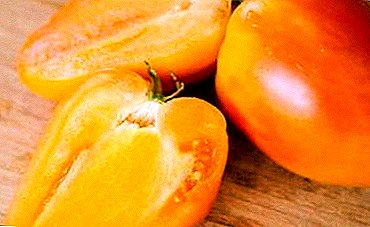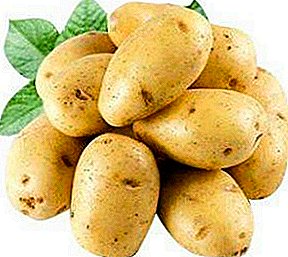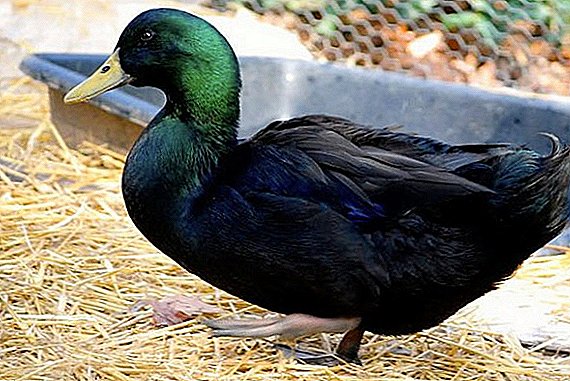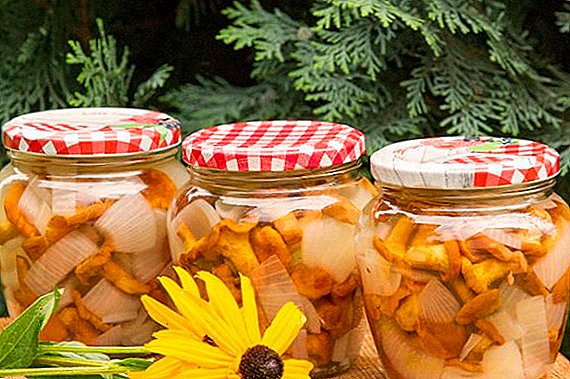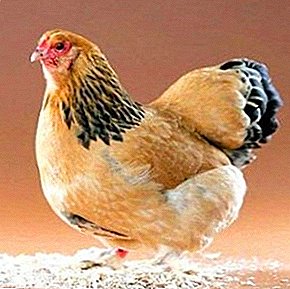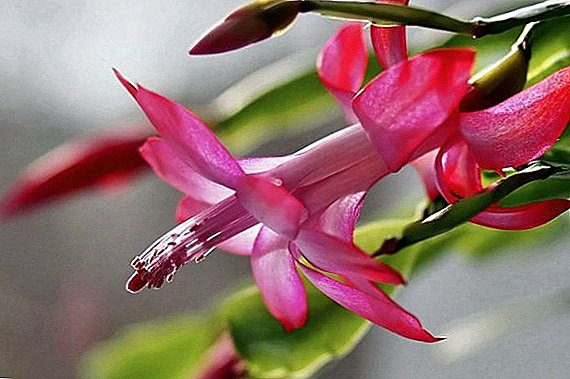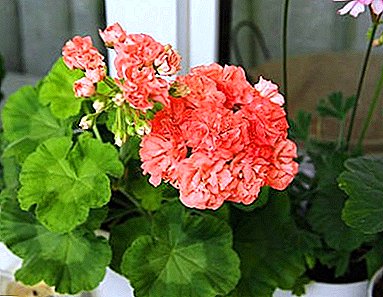 Carnation - a fairly common flower in private areas, because in addition to elegant forms, it also has a very pleasant aroma. Flower growers emit several popular varieties of this plant, and far from the last place in popularity is the carnation pinnate. Consider its features in the article.
Carnation - a fairly common flower in private areas, because in addition to elegant forms, it also has a very pleasant aroma. Flower growers emit several popular varieties of this plant, and far from the last place in popularity is the carnation pinnate. Consider its features in the article.
Botanical description
This perennial plant grows up to 30-40 cm in height, characterized by upright stems, linear sessile leaves and flowers collected in umbrella inflorescences. The root system is pivotal, the fruit is a box. As for the color of flowers, they can be white, purple and even combine several shades (for example, dark red and white). Flowering occurs in mid-summer - from the end of June and all of July.
Familiarize yourself with the most popular types of cloves, and in particular with grass, Turkish, Shabo and Chinese.
Like many other perennial plants, a feathery carnation in the first year after planting on the site will please you only with a powerful stem, and flowers will appear on the plant only from the second year of development. 
Spread
It is believed that the eastern part of Europe, as well as the central and southern territories of the Russian Federation, is the birthplace of the cirrus species, but today it is widely distributed far beyond their borders. Thus, information about its cultivation comes from North America, China and even Africa, because the attractive appearance of a feathery carnation simply cannot leave indifferent flower growers from different parts of the world.
Did you know? Carnations, which are sometimes called the “flower of Zeus,” in the old days, citizens of many countries considered a talisman, therefore they attached to the clothes of soldiers going to war (this was especially common in Italy and France).

Popular varieties of clove feathery
Breeders do not sit idle for a minute, so even the feathery type of carnations had its own varietal variations. The most popular of them are the following plants:
- Scottish Terry Clove - grows up to 40 cm and is characterized by a variety of shades of flowers.
- "Menjesti" - different white and fragrant flowers.
- Repair Form - plants grow to 25 cm, bloom twice a year (in June and in August) and may have terry or semi-double flowers.
- Plume dwarf carnation - represented by a 25-cm plant with very large flowers (up to 6 cm in diameter). Many varietal variations of dwarf carnation bloom only in winter, which is why they are often grown indoors.

Important! The planting of a pinnate carnation on its site is also of great practical importance, because its strong rhizome perfectly strengthens the soil. To this end, the plants are planted on the slopes and slopes of the site or on the edge of a flower bed with loose and fresh ground.
Use in landscape design
Depending on the variety of the feathery variety of carnations, their blooming can be observed from late May to late July, and in some cases, the flowers bloom again - closer to autumn. Therefore, it is one of the most ideal options for decorating the garden, because it is suitable for creating rock gardens and flower beds. Thanks to the lush stem part, the carnation will be an excellent option for creating ground cover carpets and bright flower pillows. In sunny areas, these plants can replace the usual lawn, and in combination with coniferous plants and roses will create a cozy home environment.
Growing at home
The described flower can not be called an overly demanding plant, so it can be grown both in open areas and in the home greenhouse, the main thing is to comply with certain growing conditions, ensuring proper care for the carnation.
Consider more details of caring for homemade cloves.

Conditions of detention
First, decide for what purpose you want to grow a flower: to decorate your home or decorate a garden. On this depends the method of planting carnations and the conditions for its further cultivation. In the first case, you will need 30-centimeter pots and sufficient space for their placement, as well as appropriate temperature conditions - about + 18… 20 ° C (in the cold season, these values may be lower). When disembarking in an open area, good illumination of the site, soil fertility and drainage are taken into account. Cirrus carnation loves light very much, but it does not tolerate flooding of rhizomes.
Soil and fertilizer
An ideal substrate for the described plant will be a mixture of sandy and loamy soil with the addition of humus and sand. In addition, we can not ignore the acidity of the substrate, which should be neutral. On acidic lands, the feathery clove grows very poorly, therefore, before it is planted, peat and sand are added, and if necessary, this mixture is supplemented with dolomite flour.
To enrich the soil and nourish the plants, use organic fertilizers: straw, pigeon droppings, Florex granulated chicken droppings, bone meal, fish meal, whey, potato peel, compost, eggshell, banana peel fertilizer and tobacco dust.

Watering and moisture
In dry weather, the plants are watered once a week, but if during this time even a small amount of precipitation has fallen, then it is better not to touch the flower. Over-wetting the soil and the high humidity of the clove does not endure, which can often hurt or even die in a matter of days. For the same reason, it is worth avoiding stagnant moisture on the site, and if necessary, it is desirable to immediately organize a good drainage system.
Familiarize yourself with the advantages of using drip irrigation, as well as learn how to organize a system of drip irrigation at the dacha.
Breeding
Cirrus varieties can be propagated in several ways, among which each gardener chooses the most suitable for themselves. Someone easier to grow out of seeds, someone prefers to use the method of grafting, and the rest growers successfully engaged in the division of the bush.
Seeds
Seeds of cloves are sown in open ground in May, but only after a good warming of the ground. Between neighboring seedlings usually leave a few centimeters of free space, and after germination thinning plantings.  Seeding carnation
Seeding carnation
In order for the plants to settle down faster in the flower bed, you can sow the seeds first on the seedlings, and later just move them to the selected area (when the seedlings have strong shoots, it will be easier for them to withstand adverse environmental factors). The process of sowing planting material in room conditions takes place in the following stages:
- Prepare a mixture of turf land, peat and river sand (1: 1: 1) and distribute it among the prepared landing tanks.
- Slightly water the soil with water, let the liquid soak in, and sow the seeds, deepening into the substrate 1-2 cm.
- Sprinkle the seedlings with a small layer of sand and cover the boxes with film.

For the first time, the boxes should be placed in a room with a temperature of at least + 18 ° C, and as soon as the young sprouts hatch, they will need to be moved to a cooler room with a temperature of + 12 ° C. As for lighting, it should be a lot, otherwise you will have to finish lighting your plantings with fitolampa.
If it is not possible to place the seedlings in the light, then you will have to reduce watering in order not to provoke the emergence of such an unpleasant illness as a black leg. One month after sowing the carnation in the pots, the young plants will need to be moved into large containers (dive), but only without deepening the root collar into the soil. Later, when the weather is warm outside, the grown plants are planted in the selected area (this usually happens at the end of May).
Important! After the appearance of 4-5 true leaves on a young sprout, it is necessary to pinch the growth point.

When planting young carnations on the site, it is important to adhere to the optimal scheme, which in this case provides for a 35-centimeter interval (over time, the plants will acquire thick leaves and stems, creating a beautiful living carpet). Full bloom can be expected only after 1-2 years.
Vegetative
If for any reason seed reproduction does not seem to be a good option for you, then you can dilute a feathery carnation on your plot by cutting or dividing the rhizome. Grafting helps preserve the varietal characteristics of the flower and is not as difficult to perform as it may immediately seem. Cuttings are obtained from shoots that do not have flowers on themselves, but with 2-3 knots and about 4-10 cm long.  Propagation of carnation vegetatively
Propagation of carnation vegetatively
All chopped "sticks" should be deepened into a container with sand a few centimeters and cover with a film on top. As soon as the cuttings have their own root system, they can be moved to the chosen place in the garden or left until spring, but at a temperature not lower than + 15 ° C. In the first case, it is possible to proceed to planting at the beginning of summer, and after wintering, the cuttings are planted only in late May.
The second method of vegetative propagation of carnations involves dividing a bush of rapidly developing plantings with many processes. There is nothing particularly difficult in this procedure: the selected shrub is carefully dug out of the ground and divided into two parts, but so that the root system is as preserved as possible. Each of the received parts landed on a separate place. It is recommended to use this breeding method at the beginning of the growth of the carnation, that is, in the spring or at the end of the summer.
Video: planting clove feathery
Relation to temperature
For regions with a temperate climate, a pinnate carnation will be a fairly frost-resistant plant that does not require any shelter even in harsh winters. However, in the northern regions with winter temperatures above -30 ° C, gardeners should better take care of additional shelter that will definitely help preserve flowers (especially young ones) until next year.
Possible difficulties in growing
Growing the flower described should not be too difficult, even for a novice grower, but some of the nuances of the process is still worth knowing. For example, the carnation does not like overwetting the soil, therefore it is desirable to exclude any possibility of flooding. In addition, you should pay attention to the weeding of plantations, especially in the case of young bushes. In this case, try not to pull out the seedlings themselves and not to damage their root system, since in the future they will not take root.
To create certain problems and violation of temperature when planting flowers. Both seeds and young plants in a flower bed may not be well tolerated by sharp drops in temperature, so it is worthwhile to carefully select the time of disembarkation or be more careful about maintaining the temperature conditions at home. 
Did you know? Clove petals can be eaten, and thanks to the sweetish taste, they can serve as a good addition to confectionery. At the same time, for pets the flower is poisonous, therefore it is grown only in places inaccessible to them.
Pests, diseases and prevention
Diseases and pests can be the biggest problem when growing cloves, although the feathery variety is more resistant to them than the rest of the cloves. The most common ailments include fusarium (a fungal disease that affects the entire plant and due to excess moisture at the root system) and rust (another result of over-wetting the soil).
If you want your carnations to be healthy and beautiful, learn how to deal with the diseases and pests of carnations.
In the first case, the main symptoms of the disease are rotting of the stem part of the flower next to the root, yellowing and twisting of the leaf plates, while in the second one there is swelling of the leaves and the complete dying off of the plant. In order to save your green pet from these misfortunes, at the first signs of affection it is necessary to treat the plant with special fungicidal preparations that are easy to find on sale (for example, Bordeaux liquid, Acrobat, Ditan, etc.). In the role of preventive measures act foliar dressing of 0.5% saltpeter. 
Among insects, the pests of carnations are earwigs, bears, and spider mites, which damage all parts: stems, leaves, and flowers. The method of control depends on the type of insect:
- When the bear invasions in the autumn, it is recommended to organize a small hole, fill manure into it and cover it with a film so that all insects crawl to wintering exactly in this place. With the arrival of spring, their refuge opens and destroys all its inhabitants. If you don’t want to wait, you can simply pour a solution of soap and water into their holes.
- If the carnations have suffered from earwigs, then wet grass will do for the construction of traps: they like to hide in it from the heat in the summer. The principle of operation of this method is similar to the previous one.
- In case of spider mite lesions, all plants must be treated with insecticides (for example, "Aktelik") or use one of the popular methods of treatment: onion peel solution, infusion of garlic or tobacco, calculated to 10 g per 5 l of water.

In addition, in any of these cases, you can use insecticidal preparations purchased in a gardening shop.
As you can see, the feathery carnation definitely deserves attention, because it is not only very beautiful, but also unpretentious in its care, which means that with minimal physical expenses you can get an excellent decorative element of your garden.
Feedback from users of the network about cloves
Elfi, these carnations need a lot of light and quite a noticeable difference in temperature at night and daytime, which is difficult to do at home. Feed a weak solution of complex fertilizer and do not pour, which is very dangerous. The situation will improve after the transplanting of seedlings into the ground, I assure you :)



